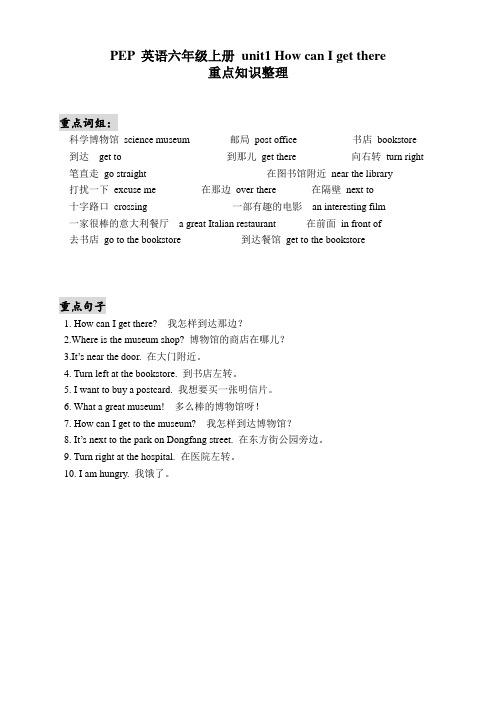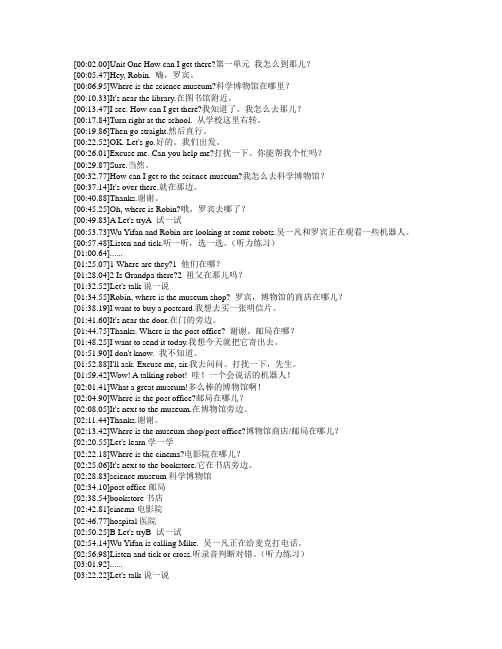2014pep六年级上册英语unit_1_How_can_I_get_there_1
- 格式:ppt
- 大小:3.35 MB
- 文档页数:28

PEP 英语六年级上册unit1 How can I get there
重点知识整理
重点词组:
科学博物馆science museum 邮局post office 书店bookstore 到达get to 到那儿get there 向右转turn right 笔直走go straight 在图书馆附近near the library
打扰一下excuse me 在那边over there 在隔壁next to
十字路口crossing 一部有趣的电影an interesting film
一家很棒的意大利餐厅 a great Italian restaurant 在前面in front of
去书店go to the bookstore 到达餐馆get to the bookstore
重点句子
1. How can I get there? 我怎样到达那边?
2.Where is the museum shop? 博物馆的商店在哪儿?
3.It’s near the door. 在大门附近。
4. Turn left at the bookstore. 到书店左转。
5. I want to buy a postcard. 我想要买一张明信片。
6. What a great museum! 多么棒的博物馆呀!
7. How can I get to the museum? 我怎样到达博物馆?
8. It’s next to the park on Dongfang street. 在东方街公园旁边。
9. Turn right at the hospital. 在医院左转。
10. I am hungry. 我饿了。


【精选】人教pep版六年级上册英语第一单元Unit1《How can I get there?》重要知识点总结Unit1 How can I get there?一、重点单词和短语Science科学museum博物馆post office邮局bookstore书店cinema电影院hospital医院tasty美味的,可口的London Eye伦敦眼stomach胃crossing十字路口turn left/turn right向左/右转go straight=walk straight直走next to紧挨着/与……相邻far from(离……远)near在……附近behind(在……后面)in front of(在……前面)between…and…(在…和…之间)二、重点句子1.How do you go to school? 你是怎样去上学的?2.where is the restaurant? 餐馆在哪里?3. Usually I go to school on foot. 我通常走路去上学。
4. Sometimes I go by bike. 有时候我骑自行车去。
5.问路之前,出于礼貌,我们要说“Excuse me”与后面的句子要用标点符号隔开。
6.Look at the traffic lights, remember the traffic rules. 看着交通灯,记住交通规则。
7.Stop at a red light.Wait at a yellow light. Go at a green light.红灯停。
黄灯等一等。
绿灯行。
8.Red means stop, yellow means wait, green means go. 红色的意思是停止,黄色的意思是等待,绿色的意思是通行。
9.How can I get to the park? 我该怎样到达公园呢?10.You can go by the No.15 bus. 你可以坐15路公交车去。

[00:02.00]Unit One How can I get there?第一单元我怎么到那儿?[00:05.47]Hey, Robin. 嗨,罗宾。
[00:06.95]Where is the science museum?科学博物馆在哪里?[00:10.33]It's near the library.在图书馆附近。
[00:13.47]I see. How can I get there?我知道了。
我怎么去那儿?[00:17.84]Turn right at the school. 从学校这里右转。
[00:19.86]Then go straight.然后直行。
[00:22.52]OK. Let's go.好的。
我们出发。
[00:26.01]Excuse me. Can you help me?打扰一下。
你能帮我个忙吗?[00:29.87]Sure.当然。
[00:32.77]How can I get to the science museum?我怎么去科学博物馆?[00:37.14]It's over there.就在那边。
[00:40.88]Thanks.谢谢。
[00:45.25]Oh, where is Robin?哦,罗宾去哪了?[00:49.83]A Let's tryA 试一试[00:53.73]Wu Yifan and Robin are looking at some robots.吴一凡和罗宾正在观看一些机器人。
[00:57.48]Listen and tick.听一听,选一选。
(听力练习)[01:00.64]......[01:25.07]1 Where are they?1 他们在哪?[01:28.04]2 Is Grandpa there?2 祖父在那儿吗?[01:32.52]Let's talk说一说[01:34.55]Robin, where is the museum shop? 罗宾,博物馆的商店在哪儿?[01:38.19]I want to buy a postcard.我想去买一张明信片。

人教PEP版六年级英语上册Unit 1《How can I get there》说课稿Unit 1 How can I get there? A Let’s learn说课稿Good morning, dear judges. I’m the second examinee. It’s my great honor to have this opportunity to interpret my teaching design here. My topic is Unit 1 How can I get there? According to the New Curriculum Standard, I will interpret my teaching design from the following parts, such as teaching aims, teaching procedures and so on.I. The analysis of teaching materialThe first part in my presentation is the analysis of teaching material. (Firstly, please allow me to talk about the analysis of teaching material) This lesson is chosen from part A Let’s learn of Unit 1 of PEP Primary English, book 7, and the main topic of this lesson is to ask and answer the way. After learning this lesson, students will be able to know how to help others find the way. Therefore, this lesson plays an important role in their studying.II. The analysis of studentsAfter analysis of teaching material, let’s move to the next step: analysis of students. Students are the subject of our class. Students of this period are active and curious. They are interested in new things after learning English for 3 years. They have some basic English background knowledge, so the teacher should attach more importance to the communication with them.III. The analysis of teaching aimsAccording to the New Curriculum Standard in English, I set the teaching aims as follows: Firstly, knowledge aim: students can understand the basic meaning of some new words, such as crossing, turn left, turn right, go along and so on.Secondly, ability aim: students can use some simple expressions and target language to communicate in daily life.Lastly, emotional aim: students are willing to help others after class.IV. The analysis of teaching key point and difficult pointThen, I want to put forward the key point and the difficult point of this lesson. Students can apply these new words and sentences naturally and appropriately.V. The analysis of teaching methodsNow I want to talk about the teaching methods. Communicative Approach, Tasked-based Teaching Method and TPR Teaching Method will be adopted in this lesson to active my students. VI. The analysis of teaching aidsTo help students learn better. I will mainly use pictures and tape recorder as teaching aids. VII. The analysis of teaching procedureNext, let’s focus on the most important part of this lesson, the analysis of teaching procedures. It consists of the following steps: warming-up, pre-listening, while-listening, post-listening, summary and homework.Now, let’s go to the first step,warming-up. In this step, I will divide students into groups Monkey 1 and Monkey 2, the one who gets banana first is the winner. Then I will sing a song named penguin’s Game. After listening, students should tell me what they have heard in this song. Then I will tell students this song is about directions. This song is closed related to the topic of this lesson. Besides, It’s very interesting for students. They would be very glad to pay attention to this lesson.Then, let’s come to the second step, pre-listening. I will draw a map and some buildings on the blackboard. Imagine I’m a foreigner and get lost. Let students help me find my way. Then I will show them some new words such as, turn left, turn right, crossing and go straight through many actions. And a word game will be arranged. It’s a bomb game. If I say a word, students should read after me quickly. But when I read the boom word, students should be quiet. Through this activity, students will be attracted and know how to read and use the new words.Now let’s talk about next period, while-listening. There are 3 activities in this step. The first activity is extensive listening. I’ll ask students to listen to the tape, then find out the main idea of this conversation. The second activity is intensive listening. I will ask students to listen to the tape once again. And try to find the answer, “Where is the Italian restaurant?” The third activity is to read. Students should read after the tape and pay attention to their pronunciation. Through this section, students could develop the ability of grasp detailed information and cooperation spirit. They will join more class activities actively.Next step is post-listening. Some students will be asked to come the front of the class, and do some actions. The other students will guess the meaning of these new words. Then I will pick one place in the map like bookstore. Ask students “Where’ the bookstore?” Students will tell me theway in their own words according to the map. Role play is very attractive for students. Students would like to take part in it very actively. By this, students can improve their speaking skills and understand how to use these sentences to communicate with others.Now, let’s move on to the summary and homework. At the end of the class, I’ll make a summary together with students. The purpose of this step is to help students recall what we have learned today. And deepen their impression of the key words and sentences. The homework is to be a guide. Tell their friends the way to the house with the target language. Next class, I’ll invite some students to share it. It can develop their independent learning ability and provide more opportunities to practice after class. At last, I will attract students attention and tell students the winner of this class.VIII. The analysis of blackboard designThe last part is my blackboard design. These are the new words and phrases. These are key sentences. It’s very clear and simple for students. And the pictures can attract students attention. That’s all for my presentation. Thank you for your listening.。

人教PEP版英语六年级上册Unit 1《How can I get there》说课稿一. 教材分析《人教PEP版英语六年级上册Unit 1 How can I get there》是一篇关于日常交际用语的课文。
本节课主要介绍了如何询问和描述路线和方向。
通过本节课的学习,学生能够掌握日常生活中常用的交通方式,如“walk”, “bus”, “bike”等,并能够运用所学知识询问和描述到达某地的路线。
教材内容贴近学生生活实际,有利于激发学生学习兴趣,提高学生英语应用能力。
二. 学情分析六年级的学生已经具备了一定的英语基础,对日常交际用语有一定的了解。
但是,学生在实际运用英语进行交际时,还存在一定的困难。
因此,在教学过程中,教师需要关注学生的个体差异,充分调动学生的积极性,引导他们积极参与课堂活动,提高他们的英语交际能力。
三. 说教学目标1.知识目标:学生能够掌握日常生活中常用的交通方式,如“walk”,“bus”, “bike”等,并能够运用所学知识询问和描述到达某地的路线。
2.能力目标:学生能够听懂、说出生日的日常交际用语,提高英语交际能力。
3.情感目标:通过本节课的学习,学生能够增强自信心,更加热爱英语学习。
四. 说教学重难点1.重点:学生能够掌握日常生活中常用的交通方式,并能够运用所学知识询问和描述到达某地的路线。
2.难点:学生能够在实际情景中灵活运用所学知识进行交际。
五. 说教学方法与手段1.情景教学法:通过设置真实的生活场景,让学生在实际情景中学习、运用英语。
2.交际法:引导学生积极参与课堂交际活动,提高他们的英语交际能力。
3.任务型教学法:通过完成具体任务,让学生在实践中掌握英语知识。
4.多媒体教学手段:运用多媒体课件、视频等资源,丰富教学内容,提高学生的学习兴趣。
六. 说教学过程1.热身(5分钟):教师与学生进行简单的英语对话,营造轻松愉快的课堂氛围。
2.引入(10分钟):教师通过展示一幅地图,引导学生谈论自己熟悉的路线和方向,为新课的学习做好铺垫。